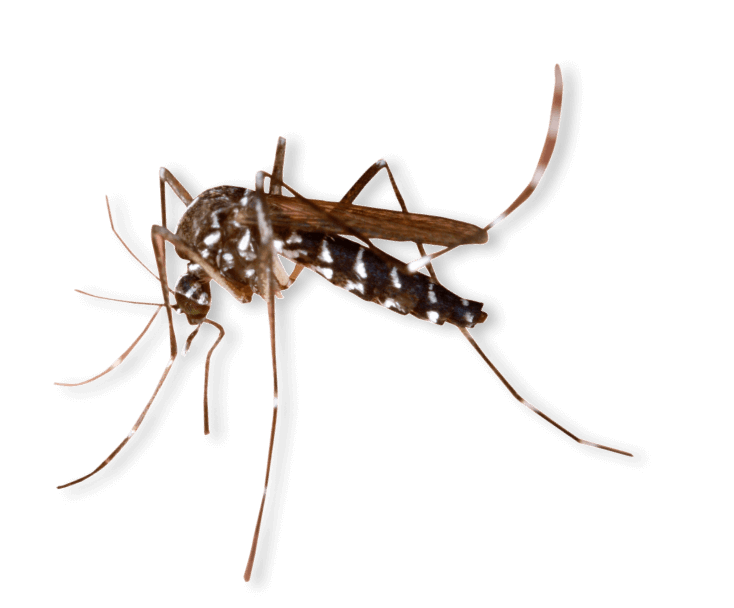
Mosquito Identification
Call Now 800-901-1102

What’s a Mosquito?
Mosquitoes transmit malaria, encephalitis, dengue and yellow fever.
Mosquitoes are small flying insects ranging from 1/8” to 3/9” long. They have small heads with large eyes, a thorax, abdomen, two wings and six very slender legs. Their coloring ranges from greyish-brown to black with white, green or blue markings. They have scales along the veins of their wings and long beak-like, sharp sucking mouth parts called a proboscis. These two features distinguish mosquitoes from other flies. Mosquitoes also have feathery or hairy antennae. They can be voracious feeders. A mosquito can show a weight gain of up to 140% with a single meal of blood. The females feed on the blood of mammals, birds, fish, reptiles and amphibians. Both males and females can feed on nectar and plant juices.ANOPHELES, CULEX AND AEDES MOSQUITOES
The main disease spreading groups of mosquitoes you’ll encounter are Anopheles, Culex and Aedes. In the event Mosquitoes become a nuisance our Mosquito Control Service can help in greatly reducing their numbers. They can be voracious feeders. A mosquito can show a weight gain of up to 140% with a single meal of blood. The females feed on the blood of mammals, birds, fish, reptiles and amphibians. Both males and females can feed on nectar and plant juices.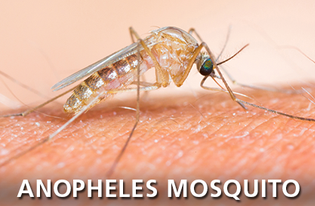
Anopheles
Species (transmits Malaria)
The body of the adult Anopheles mosquito is dark brown to black in color and has three sections which are the head, thorax and abdomen. When resting, the stomach area of the anopheles mosquito species points upward, rather than being even with the surrounding surface like most mosquitoes. The female Anopheles mosquito will mate several times in her short life span, producing eggs after she has found a blood meal. Although she only lives a few weeks to a month, she will have been able to produce thousands of eggs during that time The Anopheles mosquito is known universally as the malaria mosquito species because it is considered the primary vector of the disease. It is also a transmitter of heartworm in dogs.
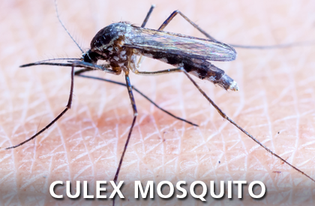
Culex
Species or House Mosquito (transmits Encephalitis)
Culex Tarsalis is a black mosquito with faint white bands on its proboscis and tarsal joints. It also has white stripes along the legs and dark chevrons on the abdomen. Both male and female feed on nectar and plant fluids. The female, when she is ready to lay eggs, feeds on the blood of both mammals and birds and prefers making an appearance from dawn to dusk. As with all female mosquitoes, a blood meal is necessary in order to reproduce. In spring the females generally feed on birds, while in late summer they seek out mammalian hosts, such as horses, cattle and humans. This species is known to contribute to the spreading of the West Nile virus, filariasis, and encephalitis.
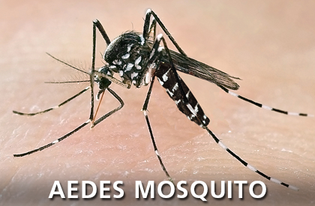
Aedes
Species or Asian Tiger Mosquito (transmits Zika Virus)
Aedes mosquitoes are visually distinct because they have black and white markings on their bodies and legs. They are active during the day in shaded areas and into the early evening. Females blood-feed primarily on humans in order to produce eggs. This species is a vector, or carrier for the following diseases, yellow fever, dengue fever, chikungunya. These viruses are passed on to humans through the bites of an infected female Aedes mosquito, which mainly acquires the virus while feeding on the blood of an infected person.
Appearance
Mosquitoes are small flying insects ranging from 1/8” to 3/9” long. They have small heads with large eyes, a thorax, abdomen, two wings and six very slender legs. Their coloring ranges from greyish-brown to black with white, green or blue markings. They have scales along the veins of their wings and long beak-like, sharp sucking mouth parts called a proboscis. These two features distinguish mosquitoes from other flies. Mosquitoes also have feathery or hairy antennae.
Eating Habits
They can be voracious feeders. A mosquito can show a weight gain of up to 140% with a single meal of blood. The females feed on the blood of mammals, birds, fish, reptiles and amphibians. Both males and females can feed on nectar and plant juices.
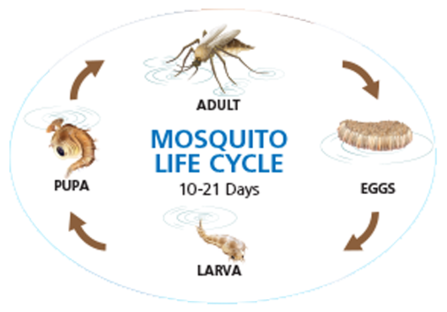
Life Cycle
Mosquitoes go through a four-stage life cycle: Egg, Larva, Pupa, and Adult. Female mosquitoes are ready to mate within a few hours after reaching their adult stage, and males are usually ready within 24 hours. Mating typically occurs while the mosquitoes are in flight, but sometimes it occurs on the ground. Most females need to obtain a blood meal before they can produce eggs. After the female mosquito obtains the blood meal, depending on species, she lays her eggs directly on the surface of stagnant water, or in a depression, or on the edge of a container where rainwater may collect and flood the eggs. The eggs hatch and a mosquito larva emerges. The larva/instar lives in the water, feeds on microscopic organisms, and then develops into the third stage of the life cycle called a pupa. The pupa also lives in the water, but no longer feeds. Finally, the mosquito emerges as a fully developed adult, ready to bite.
How long each stage lasts depends on both temperature and species characteristics. For instance, Culex might go through its life cycle in 14 days at 70° F and take only 10 days at 80° F. While other species can go through their entire life cycle in as little as four days or as long as one month.
Human Health Concerns
Every year more and more people get infected from mosquito-borne disease. Diseases transmitted by mosquitoes include:Malaria, Dengue, Filariasis, West Nile virus, Chikungunya, Yellow fever, Japanese encephalitis, Saint Louis encephalitis, Western equine encephalitis, Eastern equine encephalitis, Venezuelan equine encephalitis, La Crosse encephalitis and the Zika Virus.
Since 2003 West Nile virus, the most commonly transmitted disease from mosquitoes to humans, was responsible for 248 deaths in California.
Looking for even more information on mosquito-borne disease? Here’s some good resources.
 800-901-1102
800-901-1102

